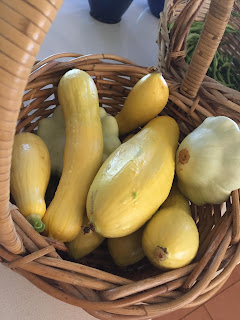East of Eden
We have been struggling with what to do after the fall of the garden and before the fall of the season. As you know we unintentionally poisoned our big garden out front this spring. That was devastating. This summer we have endured record-breaking heat and drought. Nothing is growing well, except the trees, and even they are looking a bit droopy. We are re-thinking what it means to have a garden in this kind of climate. We've come up with some ideas, but it's too hot to implement many of them yet.
We don't know how long the garden that we poisoned with manure compost that had residual herbicide in it will be unhealthy for plants. Grasses won't be bothered by the herbicide. So we are planning to convert that garden, the one in front of the Bee and the Clover into a grass and native plant demonstration garden. We plan to irrigate it so that folks will be able to see what the grasses look like when they have enough moisture. We hope that we will also be able to harvest viable seeds to add to the prairie. We also hope to collect and propagate some native plants as well.
We have plans to convert our small garden near the house into a square-foot raised garden. We hope to make it a hugelkultur garden. Hugelkultur gardening is a permaculture method of making garden beds by layering logs, branches, leaves, and other organic plant debris with compost and soil. The cellulose in the logs retains water and will add nutrients to the soil as they decompose. The square-foot method will allow us to grow things intensively in a smaller space.
We have built benches in our little greenhouse to accommodate the native plants and grasses that we are propagating.The benches are made from cinder blocks and free pallets we collected from McCoy's Building Supply. We hope to grow some things there this winter and start seedlings for the spring garden.
We are also collaborating with the Bexar Audubon Society and the San Antonio Mennonite Church to create a birding trail and a woodland garden through the property next door. The property, which once belonged to Robert's grandmother, is now leased by the San Antonio Mennonite Church.
They have incorporated into a non-profit called The Sparrow's Way, with the mission of supporting vulnerable individuals and families in healing and resilience. We have made the first steps of creating a birding trail and bird viewing area in the Sparrow's Way Woods.
We constructed an economical water dripper for the birds from a watering dish, an empty kitty litter container, and an eye screw. The water drips for about a week.
We also put a Leopold bench in the woods to watch the birds. Aldo Leopold (1887-1948), a famous naturalist, first came up with this design. We sat there this morning and in a few minutes we heard an inca dove, a northern mockingbird, a ladder-backed woodpecker, a Carolina chickadee, a mourning dove, a Carolina wren, a northern cardinal, a black-chinned hummingbird, Baltimore oriole, and a loggerhead shrike. They seem to like the water drip. We also saw a baby fawn and her mama.
She's just hidden in the bushes.
So we're diversifying the garden into a demonstration garden, a square-foot hugelkultur garden, a greenhouse garden, and a woodland garden to try to adapt to our own mistakes and the changing climate. Diversity in the prairie is an indicator of health. So maybe diversity in our gardening will be more healthy. We'll check back in on the progress.












Comments
Post a Comment